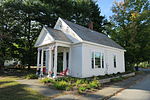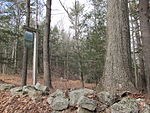Burley Hill (Connecticut)
Landforms of Tolland County, ConnecticutMountains of ConnecticutUnion, Connecticut
Burley Hill is a 1,316-foot (401 m) hill in Union, Connecticut. It is the highest point in Tolland County and the highest point in eastern Connecticut. It is one of Connecticut's highest named summits and it ranks 6th in the state for prominence at 669 feet.It is the most isolated peak in Connecticut and ranks 47th out of 50 for separation. The nearest summit above 1316' is 1387' Asnebumskit Hill in Massachusetts, 25.2 miles away.
Excerpt from the Wikipedia article Burley Hill (Connecticut) (License: CC BY-SA 3.0, Authors).Burley Hill (Connecticut)
Burley Hill Road,
Geographical coordinates (GPS) Address Nearby Places Show on map
Geographical coordinates (GPS)
| Latitude | Longitude |
|---|---|
| N 42.0170402 ° | E -72.2086891 ° |
Address
Burley Hill Road 10
06076
Connecticut, United States
Open on Google Maps








